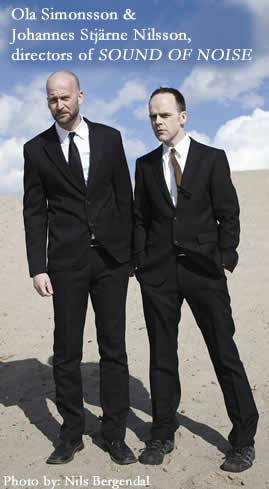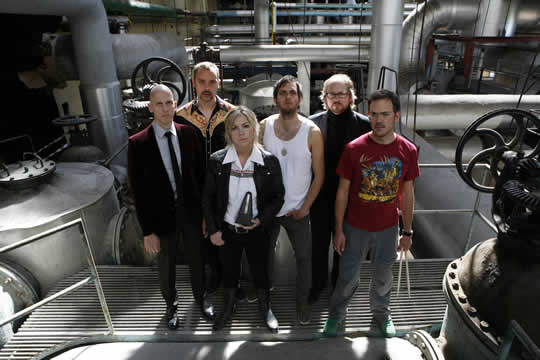 In Sound Of Noise a Swedish film, Police officer Amadeus Warnebring has been born into a musical family with a long history of famous musicians. Ironically, he hates music. His life is thrown into chaos when a band of crazy musicians decides to perform a musical apocalypse using the city as their orchestra… Reluctantly, Warnebring embarks on his first musical investigation…
In Sound Of Noise a Swedish film, Police officer Amadeus Warnebring has been born into a musical family with a long history of famous musicians. Ironically, he hates music. His life is thrown into chaos when a band of crazy musicians decides to perform a musical apocalypse using the city as their orchestra… Reluctantly, Warnebring embarks on his first musical investigation…
Johannes Stjärne Nilsson and Ola Simonsson directors of Sound Of Noise were both born in Lund, Sweden in 1969 and have known each other since the age of 7, when they performed together in a school play. Since completing a Master’s degree in Fine Arts in Stockholm, Johannes has been a graphic designer, a cartoonist, a director and a producer. Ola graduated from Malmö Conservatory of Music and is a musician, a singing teacher, a director and a composer.
Neither studied film in school or followed any training in this field. Their short Music For One Apartment And Six Drummers was screened in Official Selection at the 2001 Cannes Film Festival and has won more than 30 international awards. In 2006, the Swedish duo returned to the Croisette with the Critics’ Week-selected short Woman And Gramophone after having been already invited in 1996 for Nowhere Man.
Past activities as graphic designer and musician are palpable in the directing and the scoring of their work. Colored with absurdity and always filled by a genuine curiosity for the human mind and its motivations, their work can be compared to that of Jacques Tati, Roman Polanski and countryman Roy Andersson.
Sound Of Noise is their first feature.
Bijan Tehrani: You have come a long way from “Music for One Apartment and Six Drummers.” Please tell me a little bit about your obsession with music and sound and how you ended up hear with “The Sound of Noise”.
Johannes Stjärne Nilsson: As you said, it all started with the short film, “Music for One Apartment and Six Drummers”. About 10 years ago, when that idea of making music came up, we saw it as very much of an  experiment. We wanted to see, not only if we could make music out of our household objects, but if it was possible to make the music danceable and more pop based, so I think that was the experiment. Then we also wanted to know if we could make a film out of it that was equally based on the sound of music on the official side, so we really did not have very big expectations for the film. We thought that this would probably be popular with more experimental musicians. We found out that this was something that really communicated to a lot of people from many different countries and cultures, and we found out that music was really a universal language. With that discovery, we also got more curious to know if we could bring it further. We had no intention whatsoever to make a feature out of it, but we did a lot of live concerts with the drummers, playing on all kinds of things and, more and more, ideas were gathered and in the end we had to just explore this further and see if we could make it in the larger scale.
experiment. We wanted to see, not only if we could make music out of our household objects, but if it was possible to make the music danceable and more pop based, so I think that was the experiment. Then we also wanted to know if we could make a film out of it that was equally based on the sound of music on the official side, so we really did not have very big expectations for the film. We thought that this would probably be popular with more experimental musicians. We found out that this was something that really communicated to a lot of people from many different countries and cultures, and we found out that music was really a universal language. With that discovery, we also got more curious to know if we could bring it further. We had no intention whatsoever to make a feature out of it, but we did a lot of live concerts with the drummers, playing on all kinds of things and, more and more, ideas were gathered and in the end we had to just explore this further and see if we could make it in the larger scale.
Bijan: How much has your friendship with Johannes helped you to get here? It’s seems difficult to collaborate on a seamless film like this, which looks like it came from one mind.
Ola Simonsson: To tell you the truth, we have different favorite scenes, and we do not always think the same, but maybe it is kind of a filter that we have; we share the same humor and we have pretty much the same taste when it comes to things, and maybe we share a view about how we look at the world. One thing that we kept is that we always tried to be faithful to the subject and to cherish that integrity. You are allowed to play and allowed to have fun while you work because this can be a very tiring business. There are a lot of things that are hard and difficult, but if it’s not fun it’s not really any use to work with it.
 Bijan: How much has your background in music helped with your projects?
Bijan: How much has your background in music helped with your projects?
Ola: I don’t really see it as helping; it is just so natural to work very closely with music. I think a lot of music can be used with words and terms when it comes to film. You work with tempo and moods and dynamics, and when you edit the film it can be very musical. Johannes has very good ear for music.
Bijan: There are people who have started to follow the music for “One Apartment and Six Drummers” on YouTube. Some have started to call it a cult film; do you consider this a cult film?
Johannes: I would not know how to define that. I’m, as I said earlier, surprised at the reaction that the film got and we were happy for that. That is like a gift in a way that you can’t foresee it and, ten years later, the film is watched by thousands of people daily. I don’t know really what it is that triggers people and makes it interesting, but I can just be grateful for it. It lives its own life, totally.
Bijan: From what I understand. you kept some of the people who were in the first short and brought them into “The Sound of Noise”, is that correct?
Johannes: Yes, we have them based on the same six drummers and six musicians, but we have a different back-story for them. We have been making shorts and documentaries with them for many, many years and, in doing that, we have also created a creative family where the people who we have gathered for the projects are involved with the feature.
Bijan: It seems that you took a long break since you decided to make “The Sound of Noise”. Did you conduct a lot of experiments prior to shooting the film?
Johannes: Yes, and we have also been developing a live show with the drummers that we are working with. It is all a part of a long process of discovering music and how to think more freely and use instruments more freely. With this show, we mix live drummers and live objects that we play on, and it’s something that we find very exciting and interesting. Between the short film and feature, we not only made other shorts and other artistic work, but we also did these small concerts with objects. Also, when we developed the script for the film, we had to work with the music in parallel because we really did not see what would work musically until we had actually tried it properly. We spent a great deal of time actually creating sounds, then recording them, and then trying to make music out of these sounds. So the composer of this film, he composed thousands of these sounds in his lab and spent a very long time making music. We also discovered that some sounds simply did not lend themselves to music, so we had to rethink and rewrite the script, and that was a long process indeed.
Bijan: There is a blend of very fresh humor and fresh ideas in this film—I have been watching films for five or six decades and I can tell you that this is one of the freshest movies that I have seen in that  last twenty or thirty years.
last twenty or thirty years.
Ola: Well that is nice to hear, thank you.
Bijan: How did you go about blending the humor to the subject of the film?
Ola: This is the way we have always worked—to make different styles and genres without really thinking too much into it. We just want it to be a film that fits on the shelf in the DVD store. I think this is how we work: we like to have this constant balance between dark humor and some absurd styles so we try to do films that we would actually watch. We want to see if we can make something that has both humor and some humanity in it.
Bijan: I moved from Iran twenty three years ago, and that is a country where many different kinds of music are banned and there are about two thousand underground bands and musicians. Your movie seems fit to be shown there. Did you know about this issue?
Ola: Yes, I’ve had an interview with an Iranian heavy metal band and they had to rehearse very secretly. It was very hard for them because it is very loud music, but they found a place where they could play very loud without anyone else hearing. I think that a lot of regimes are afraid of music because music is a very powerful weapon. It was a very powerful weapon against apartheid machines and also the Soviet Union. You had a lot of protest songs and they can be more or less explicit. In the Soviet Union you had bards sing songs, and you had people copy them on cassette tapes. Music can be a tool that is impossible to kill.
Bijan: What do you think of your films chances in the US? Have you screened the film in the US yet?
Ola: Yes, we screened it is Austin at the fantastic festival there and we won the big prize. I hope it can find its audience here and, so far, there has been a nice buzz around the film and we hope it will find a large audience here.
Bijan: Also, I am sure that winning the Cannes Film Festival young critics award has been important, as well as the Palm Spring Film Festival’s New Vision award. Congratulations on those accolades. Do you have any new projects lined up?
Ola: We are working more with the drummers to make a longer live performance, and we are also writing new feature film scripts.
Bijan: I’m looking forward to your future work, best of luck!

